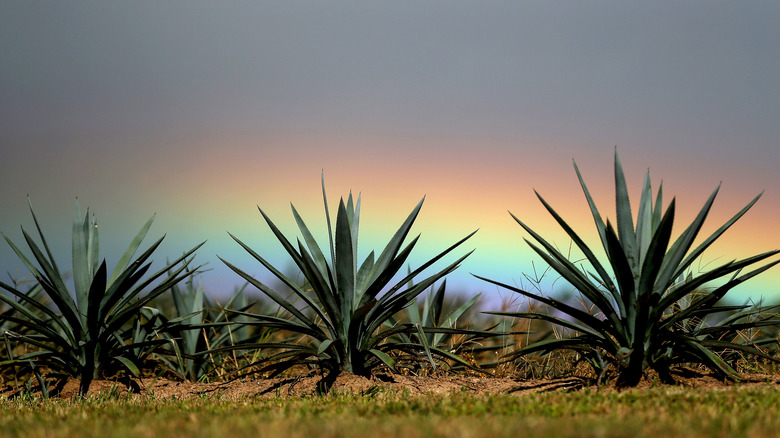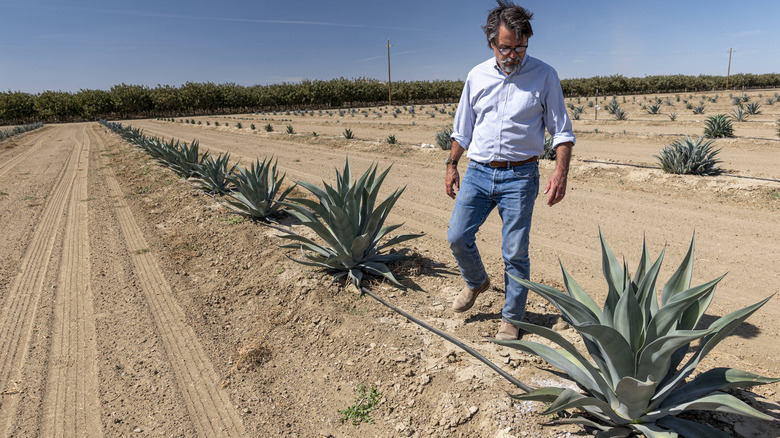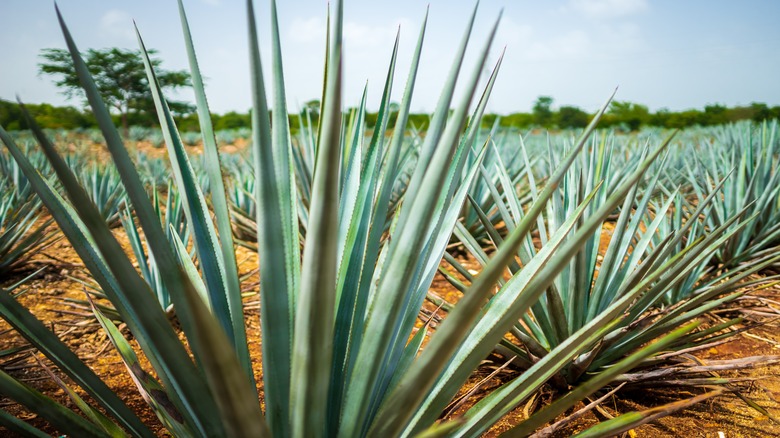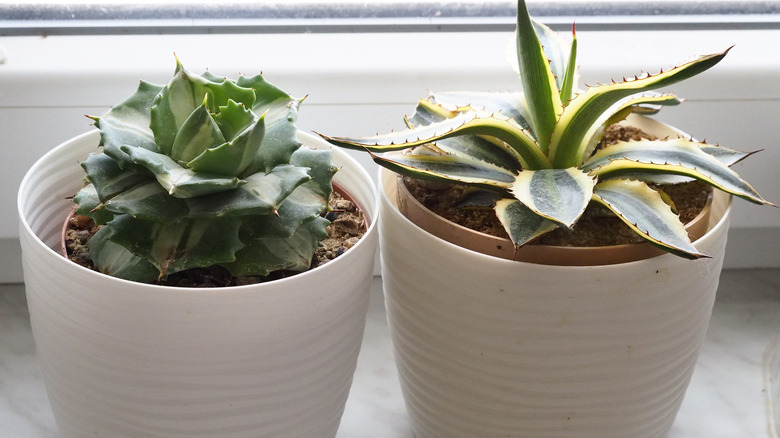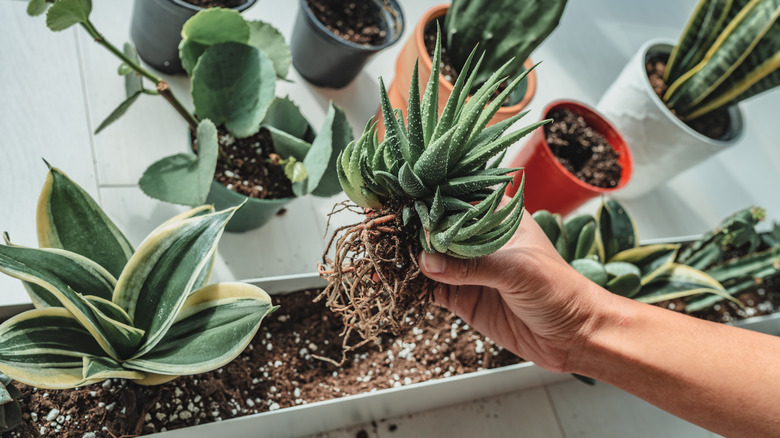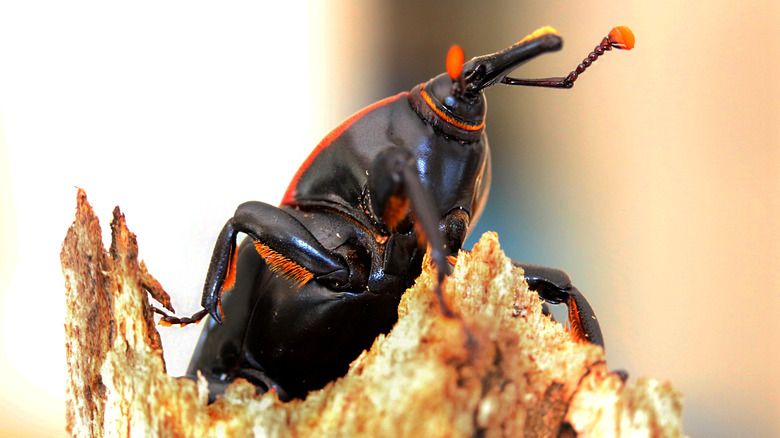How To Care For An Agave Plant
Agave is a genus of succulent plants native to arid regions of the Americas — most notably Mexico and Central America. Agave plants have been used by the native inhabitants of Mexico for centuries. One of its earliest known uses was to make pulque, Mexico's first alcoholic beverage that is still consumed today, according to BBC. The different species of agave have varying features; leaf size can range from just centimeters up to 8 feet long. Leaves are typically symmetrical with pointed ends and have a thick, leathery texture. The plants range in color, from blueish gray to green. They are often mistaken for cactus plants or aloe.
Most agave species are considered monocarpic, meaning they flower only once before dying. It typically takes several years for agaves to flower, and when they do, they leave behind seeds so that a new plant can grow. In farming, they are usually harvested right before flowering. Since agave plants are adapted to harsh desert conditions, they are relatively low maintenance and easy to care for at home. This makes them a popular choice among home gardeners.
How to grow agave
Agave can be grown indoors as well as outdoors when exposed to the proper climate. Your agave plant will grow best in temperatures between 65 and 80 degrees. If you plan to keep your plant outdoors, you will need to make sure the climate is conducive to proper growth. According to Garden Design, subtropical zones with dry periods, like those with Mediterranean or Southwestern climates, work best for growing agave. If you want to grow an outdoor agave plant in a colder or more humid climate, it may require additional protection, like a greenhouse. Too much humidity will cause the plant to rot, and it will not be able to thrive in cold weather.
When growing outdoors, the experts at Masterclass suggest digging a hole about double the width of the plant's original pot. Keep the depth of the hole the same as the original container, as succulents tend to have shallow roots. They also suggest using a layer of cactus soil.
How to care for agave
Once your agave is planted, the key to its healthy growth is ensuring that the plant gets enough sunlight. When growing indoors, make sure that your agave plant is facing a window that has plenty of access to light. You should then rotate the plant every few weeks to make sure that each side gets sun exposure.
During the plant's first month, it is best to water once every five days. After its initial growth period, you will water less frequently. Outdoor agave plants will only need to be watered in the case of an extended drought after their initial growth period. For indoor plants, Water every one to two weeks in the summer, making sure the soil has partially dried in between. During the rest of the year, you can wait up to a month between watering. Be cautious of overwatering — this can be damaging to agave. Nearly-dried soil is a good indicator that it is time to re-water. Mixing sand in with the soil can help prevent overwatering. According to The Spruce, most agave plants do not require fertilizer, and using one can even be detrimental to their lifespan.
Varieties of agave
There are around 200 species of agave, according to Britannica. One of the most well-known is blue agave (Agave tequilana), which is used in the production of tequila. Although there are a variety of species, agave plants require similar care and are relatively easy to grow because they don't require a lot of maintenance. However, you'll need patience because the plants typically take several years to flower and grow to full maturity. Here are a few species of agave worth looking into if you're considering this plant in your home or yard, per The Spruce.
- Agave americana is known as the "century plant" because it takes a notoriously long time to flower. This species is native to Texas and Mexico, and its leaves grow between 3 to 5 feet in length.
- Agave victoriae-reginae grows to be only 10 inches tall and is often used for decoration. This is a good option for those looking to grow agave in a colder climate because it is one of the most cold-resistant species.
- Agave parviflora is native to the Sonora desert and grows less than a foot tall. It is distinguishable by its long, thin leaves and white markings.
- Agave colorata is a good option for someone looking for a mid-sized plant because it typically grows between 1 to 3 feet tall. This species is distinguishable by its blue leaves.
Are agave plants toxic?
Unfortunately, agave plants are mildly toxic to both humans and pets. According to Plant Care Today, all parts of the agave plant, with exception of the flower, are toxic when unprepared. When agave sap comes in contact with skin, it can cause blisters, sun sensitivity, rashes, and swelling. Puncture wounds from the sharp edges of the leaves can cause severe irritation, so it is important to wear thick gloves and long sleeves when handling agave plants. Rinse any areas of the skin that come in contact with agave sap. Do not consume the plant when unprepared.
If your pet consumes the plant, it is unlikely to be fatal, but they may experience redness or irritation around the mouth, swelling of the throat, or vomiting and diarrhea.
Although it's best to avoid consuming agave in its natural state, Mashed notes that there are plenty of delicious ways that people use agave in cooking. And obviously, there's always tequila.
How to repot an agave plant
It is only necessary to repot agave about once a year. When doing so, it is important to wear gloves since the sap produced by the agave leaves can be toxic and cause skin irritation. Give the plant fresh potting soil mixed with sand for increased drainage. You may need to use a slightly larger container when repotting. To avoid crown rot, a common issue among agaves, make sure that the crown of the plant is completely above the soil.
When repotting, it is a good time to check on the roots of your plant and give them any necessary care. Martha Stewart suggests checking for pests in the soil, trimming roots for better circulation, and removing any dead leaves. She also suggests removing any "pups" or plant offshoots that have formed their own roots. Once they are removed, they can be planted on their own and grow to full-sized agaves.
Common problems with agave plants
As mentioned before, agave is a low-maintenance plant, which makes it fairly resilient when kept in the right conditions. According to The Spruce, signs of issues with agave plants are yellow or drooping leaves, which can be an indicator of overwatering or insufficient sunlight. If this is the case, check to make sure that your plant is not getting extended periods of shade. Sandy soil can ensure that the plant is drained properly and prevent overwatering.
Agave plants are also susceptible to pests, particularly the agave snout weevil and cactus longhorn beetle. Using an insecticide can keep these insects from infesting your plant. If your plant does become infested, it is best to remove it from the area to prevent the spread to other plants until the bugs are eradicated.
Brown or red spots can signal anthracnose, a fungal infection caused by overwatering or humid conditions. In this case, it is also best to remove the plant in order to prevent the spread and then treat it by removing infected limbs or using sulfur powder.
